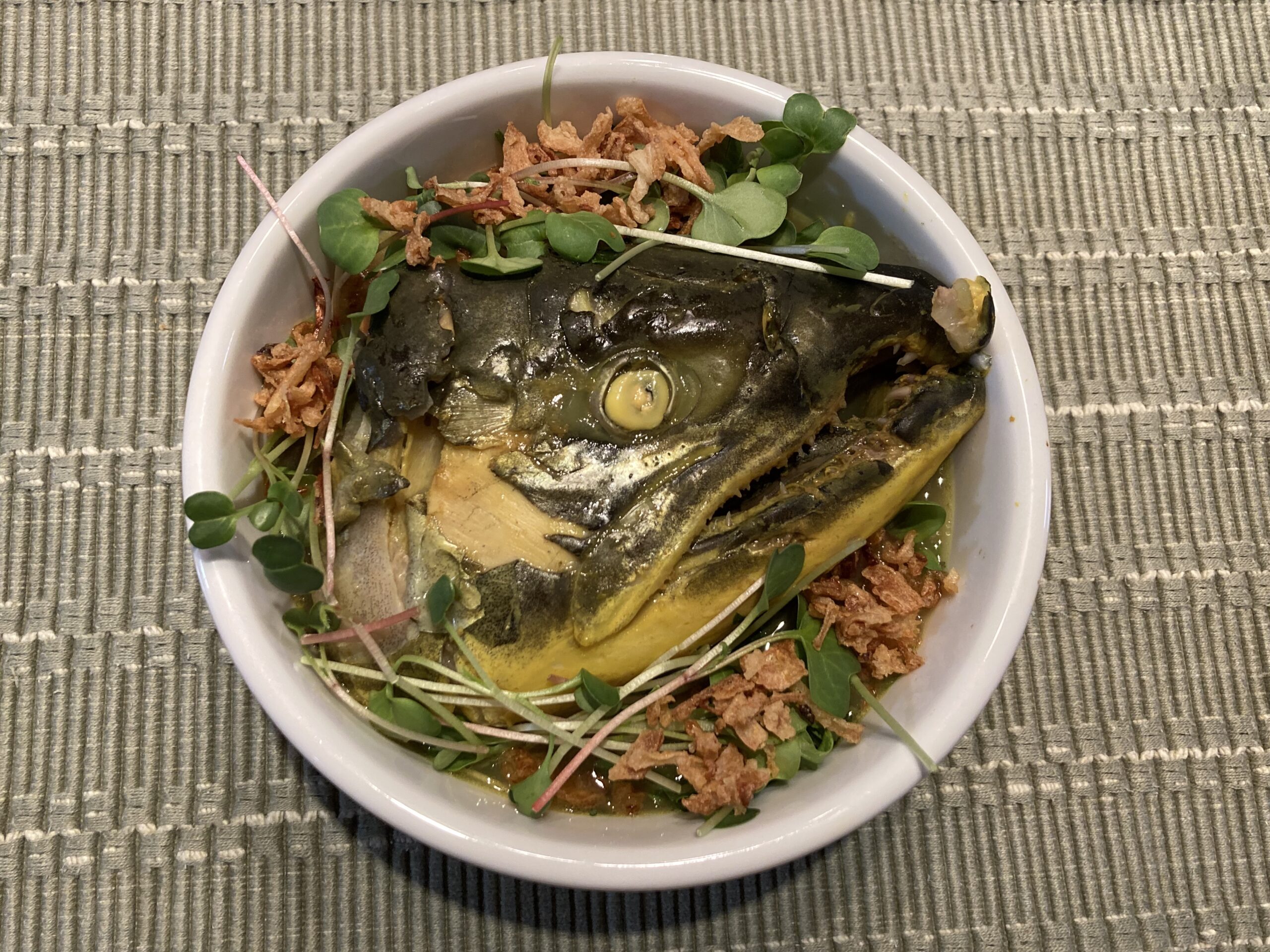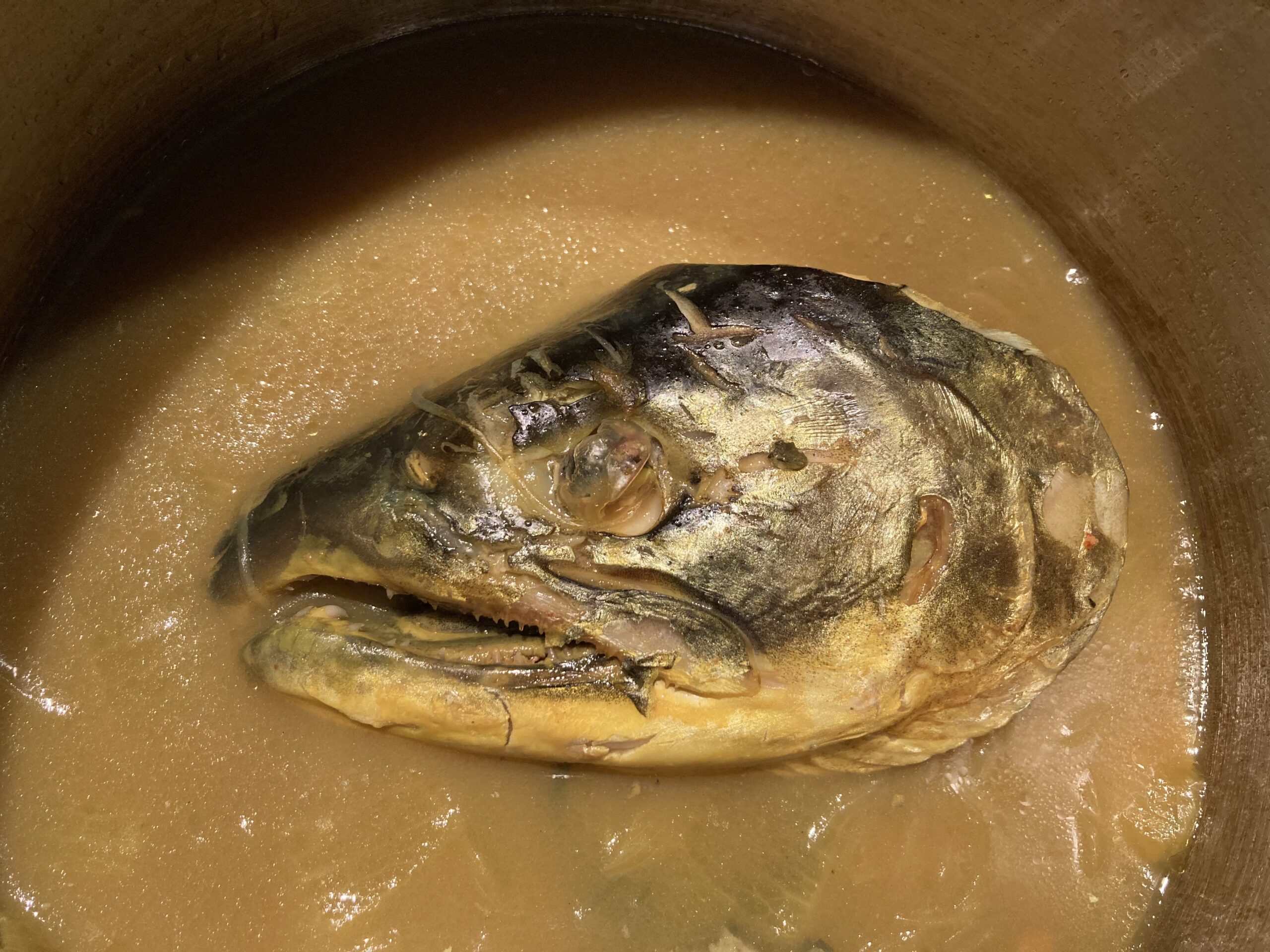
This month we are celebrating the early runs of salmon with a delicious fish head soup recipe provided by Jennifer Nu, regional food systems catalyst for the Sustainable Southeast Partnership. Fish head soup is an important food in many cultures, especially to the Indigenous communities of Southeast Alaska and also in Southeast Asia. Not only does this soup appear in traditional stories, but it is also an integral aspect of the gift economy as well as a dietary staple for Alaska Natives.
For Alaska Native communities, the significance of fish head soup goes far beyond its culinary appeal. It represents a connection to their ancestors, a celebration of their relationship with the land and water, and embodies the care in relationships between one another. The practice of utilizing the entire fish, including the head, exemplifies the deep respect and care for their nonhuman kin. Through the community’s embrace of the gift economy, where resources are shared and reciprocated, fish head soup becomes a symbol of unity, care and cooperation.
The act of preparing and sharing this soup becomes an opportunity for people to come together, share their stories and knowledge, and provide for their community through the gifting of this soup to Elders or those that may be sick. Fish head soup is often a remedy during cold and flu season, as it provides an excellent source of minerals such as calcium and phosphorus, as well as an abundance of vitamins A, C, D, E and omega-3 fatty acids.
Despite the impacts of colonization, fish head soup continues to be an integral part of Alaska Native food systems. By honoring and celebrating fish head soup, Indigenous communities strengthen their cultural identity, preserve their ancestral practices, and continue to thrive within the framework of their unique social and ecological systems.
In addition to its importance in Alaska Native communities, this soup also is widely cherished in many other cultures and traditions. Jennifer Nu shared her version of this soup with the Indigenous Aquaculture Network, inspired by her current home of Alaska as well as incorporating flavors from her own Southeast Asian heritage. In her role at the Sustainable Southeast Partnership, Jennifer supports the many projects that engage Southeast Alaskans in strengthening their relationships with place-based, local food systems. This recipe not only celebrates Jennifer’s heritage, but also highlights the connections to land and sea in Southeast Alaska, celebrating the local and traditional coastal foods of the area.

“This is a soup inspired by the Southeast Asia homelands of my parents. Usually made
with fish broth from local fish, I decided to use salmon fish heads from whole fish I had
purchased from a commercial fisherman in Pelican, Alaska. Yakobi Fisheries, the local processor, offers and welcomes custom processing requests, so I asked for heads to be kept, and also requested the bellies and collars to be kept on the fillets. To my delight, they also scraped the backbone to make “salmon burger” meat, which adds up to a delicious quantity of food that oftentimes gets discarded. Whenever I encounter fishermen (whether subsistence, commercial, or sports) or harvest fish with friends and I see an edible part of the fish that is not going to be used, I’ll ask for it and I am usually able to glean a substantial amount of underutilized, nutritious fish pieces to stock the freezer and share with others.”
– Jennifer Nu
Ingredients
1 small onion, diced
3 cloves fresh garlic minced or 2 tsp powdered garlic
Several pieces fresh ginger, grated or sliced
1-2 stalks lemongrass
2 tsp turmeric powder
Five salmon heads
Enough water to cover the heads
1 teaspoon salt (or fish sauce)
Noodles of your choice (cellophane noodles, udon, somen, egg, hand-pulled, etc.)
Cilantro or other seasonal green garnish
Fried crispy onion
Instructions
Combine fresh onion, garlic, ginger, lemongrass, and water. Bring to a boil. Simmer the mixture for 5-10 minutes. Add fish heads and simmer until cooked through. It’s best to not overcook so that the head stays intact. Add noodles. When noodles are cooked, serve and garnish with crispy onion and cilantro.
Salmon heads are large and rich in nutritious fish oils. Have a bone plate ready to put all the small pieces in. Enjoy the soft meat and crunchy clear cartilage pieces. This is a dish best enjoyed slowly eating to savor the flavor and being careful with small pieces of bone and teeth.
Note: If you are processing fish heads on your own, make sure to remove the gills.
Photos provided by Jennifer Nu. Blog written by Olivia Horwedel, Indigenous Aquaculture Communications Fellow.
